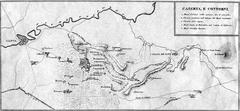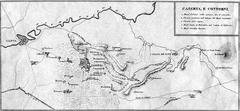Torre Dei Falconi: Visiting Hours, Tickets, and Travel Guide to Caserta’s Historic Tower
Date: 03/07/2025
Introduction
Torre Dei Falconi, rising above the medieval village of Casertavecchia in Italy’s Campania region, is a striking symbol of Caserta’s feudal and architectural heritage. This iconic tower not only represents centuries of military and noble influence but also stands as a cultural beacon, connecting Caserta’s present to its storied past. From its Lombard origins through Norman and subsequent feudal rule, Torre Dei Falconi has evolved in both function and form, encapsulating the dynamic power shifts in southern Italy (napoli-turistica.com; reggiadicaserta.cultura.gov.it).
This comprehensive guide explores the tower’s fascinating history, architectural evolution, ticketing options, accessibility, and nearby attractions. It also highlights Caserta’s vibrant local culture, sustainable tourism practices, and practical travel tips—helping you make the most of your visit to one of Italy’s most authentic medieval landmarks. For real-time updates and ticket booking, consider downloading the Audiala app (italia.it).
Table of Contents
- Discover Torre Dei Falconi: A Medieval Gem
- Historical Background
- Architectural Features and Significance
- Cultural Importance and Local Legends
- Visiting Torre Dei Falconi: Hours, Tickets, and Practical Tips
- Accessibility and Getting There
- Preservation and Visitor Experience
- Integration with Caserta’s Broader Heritage
- Local Culture, Gastronomy, and Traditions
- Nearby Attractions
- Sustainable Tourism Practices
- Frequently Asked Questions (FAQ)
- Summary and Visitor Recommendations
- Sources
Discover Torre Dei Falconi: A Medieval Gem
Torre Dei Falconi stands as the tallest and most prominent remnant of the medieval castle complex of Casertavecchia—a hilltop village predating modern Caserta. With its 30-meter cylindrical stone structure, the tower once provided critical defense and surveillance, and today it offers panoramic views of the Campanian plains.
Visitors can explore the exterior and castle ruins year-round, immersing themselves in the atmosphere of a bygone era. While interior access is limited to special events, the site remains a focal point for historical tours and cultural festivals (italiani.it).
Historical Background
The origins of Torre Dei Falconi date back to at least the 9th century, when the Lombards constructed it as a stronghold against Saracen incursions. Over the centuries, the tower was expanded and modified by the Normans, Swabians, and Aragonese, reflecting the strategic importance of Casertavecchia (napoli-turistica.com; campaniashopping.it).
The tower’s significance was further elevated during the reign of Emperor Frederick II and by notable residents like Countess Siffridina. As the population eventually shifted to the plains, the prominence of Casertavecchia and its castle waned, paving the way for the construction of the Royal Palace in the 18th century (italiareportusa.com).
Architectural Features and Significance
Torre Dei Falconi’s robust cylindrical design—nearly 30 meters tall—made it one of Europe’s tallest medieval towers. With thick stone walls, minimal openings, and a series of defensive battlements, the tower was built to withstand sieges while providing surveillance over the surrounding landscape. Inside, a spiral staircase leads to the upper levels, which historically served as the lord’s residence, with lower floors used for storage and servants (lifeinitaly.com).
The surrounding castle remains offer further insight into medieval fortification and daily life, including storerooms, stables, and drawbridge supports. Today, visitors can explore these atmospheric ruins and enjoy exceptional photographic vistas (aleintravel.it).
Cultural Importance and Local Legends
Beyond its architectural value, Torre Dei Falconi is embedded in local lore. Its name references the falcons historically kept for noble hunting—a tradition that underscores the tower’s aristocratic connections. Legends, such as those involving Countess Siffridina and tales of secret passages, enrich the site’s mystique (italiareportusa.com).
The tower is a centerpiece for annual festivals like “Settembre al Borgo” and “Un Borgo di Libri,” drawing locals and tourists alike into the heart of Caserta’s cultural life (italiani.it).
Visiting Torre Dei Falconi: Hours, Tickets, and Practical Tips
Visiting Hours
- General Access: The exterior and castle grounds are open year-round, typically from 9:00 AM to 6:00 PM.
- Interior Access: Entry to the tower’s interior is limited to special events, heritage days, or guided tours. Always check the official Caserta tourism website for the latest schedule.
Ticket Information
- Exterior Grounds: Free entry year-round.
- Special Events: Interior access may be free or require a nominal fee (usually €3–€10). Tickets should be reserved in advance during festivals or FAI Days.
Guided Tours
- Available during special events, often in Italian and English.
- Recommended for in-depth historical insights and access to restricted areas.
- Booking ahead is advised due to limited availability.
Accessibility
- The village’s cobblestone streets and uneven terrain can be challenging for visitors with mobility concerns.
- The tower itself has a steep spiral staircase and is not wheelchair accessible, but the ground floor and surrounding areas are generally reachable.
Getting There and Parking
- Casertavecchia is about 10 km from Caserta city center and 5 km from the Royal Palace.
- The historic center is pedestrian-only; parking is available outside the village.
- Limited public transport—renting a car is recommended (understandingitaly.com).
Preservation and Visitor Experience
Torre Dei Falconi is less restored than high-profile landmarks like the Royal Palace, offering a more authentic medieval encounter. Informational plaques and local guidebooks provide context for self-guided visits, while the surrounding village atmosphere enhances the experience (lifeinitaly.com).
Integration with Caserta’s Broader Heritage
The medieval streets and monuments of Casertavecchia, including the Cathedral of San Michele Arcangelo and castle ruins, provide a striking contrast to the Bourbon grandeur of the Royal Palace. Walking tours are the best way to appreciate the compact village and its rich history (discoveringcaserta.com).
Local Culture, Gastronomy, and Traditions
Casertani Identity and Festivals
The people of Caserta—Casertani—are known for their pride in local history and tradition. Festivals like Settembre al Borgo showcase music, theater, and street food, while religious processions and open-air concerts enliven the summer months (travel365.it).
Gastronomy
Don’t miss the region’s mozzarella di bufala campana DOP, rustic breads, fresh pasta, and local wines like Asprinio di Aversa DOC. Village trattorias offer authentic Campanian cuisine (traveltoitalyguide.com).
Arts and Nightlife
Caserta’s arts scene includes year-round theater performances, galleries, and a lively nightlife centered around historic piazzas and nearby Aversa (travel365.it).
Nearby Attractions
- Royal Palace of Caserta (Reggia di Caserta): UNESCO World Heritage site with opulent interiors and vast gardens (iamitalian.com).
- San Leucio Complex: Historic silk-production center.
- Acquedotto Carolino and Valle di Maddaloni: 18th-century engineering marvel.
- Bosco di San Silvestro: WWF-protected natural oasis and education center.
- Planetario di Caserta: Interactive astronomy museum.
Sustainable Tourism Practices
- Eco-Friendly Transportation: Use public transport, bicycles, or electric vehicles where possible. Palace gardens offer bike rentals.
- Responsible Visitor Behavior: Respect local customs, minimize waste, and support local businesses and artisans.
- Conservation Initiatives: Participate in workshops or guided eco-tours in protected areas like Bosco di San Silvestro.
- Accessibility and Inclusivity: Many sites provide ramps, multilingual guides, and special tours for visitors with disabilities (travel365.it).
Frequently Asked Questions (FAQ)
Q: What are the visiting hours for Torre Dei Falconi?
A: The exterior is generally open from 9:00 AM to 6:00 PM; interior access is limited to special events.
Q: Do I need tickets?
A: No tickets for the exterior. Interior visits during special events may require a nominal fee.
Q: Are guided tours available?
A: Yes, during special events and by advance booking.
Q: Is the tower accessible for people with disabilities?
A: The ground level and surroundings are accessible, but the tower’s upper levels are not.
Q: What other sites should I visit nearby?
A: The Royal Palace, Casertavecchia’s cathedral, Acquedotto Carolino, and Bosco di San Silvestro.
Summary and Visitor Recommendations
Torre Dei Falconi is a must-visit for history lovers and cultural explorers seeking an authentic glimpse into southern Italy’s medieval past. While interior access is limited, the site’s panoramic vistas, rich legends, and vibrant local culture make for a memorable experience. Plan your visit around special events or guided tours for added depth, and embrace sustainable tourism by supporting local businesses and respecting conservation efforts. For real-time updates and exclusive guides, download the Audiala app and consult official tourism resources (italiani.it; napoli-turistica.com; travel365.it).
Sources
- Torre Dei Falconi: Visiting Hours, Tickets, and History of Caserta’s Medieval Tower, 2025, (italiani.it)
- Torre Dei Falconi Visiting Hours and Tickets: A Complete Guide to Caserta’s Historic Tower, 2025, (napoli-turistica.com)
- Visitor Guide: Torre Dei Falconi Visiting Hours, Tickets & Caserta Historical Sites, 2025, (italia.it)
- Visiting Torre Dei Falconi: Hours, Tickets, and Exploring Caserta’s Historical Sites, 2025, (travel365.it)
- Life in Italy: Caserta, 2025, (lifeinitaly.com)
- Understanding Italy: Caserta Province, 2025, (understandingitaly.com)
- Reggia di Caserta: Italy’s Answer to Versailles, 2025, (iamitalian.com)



